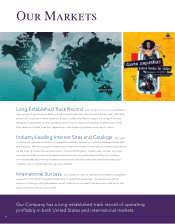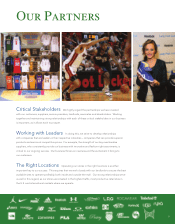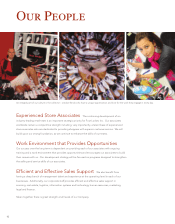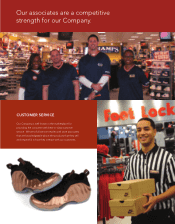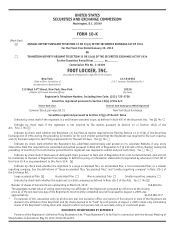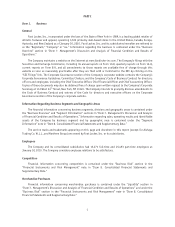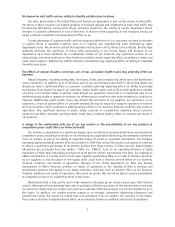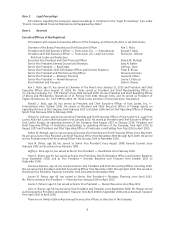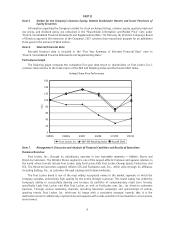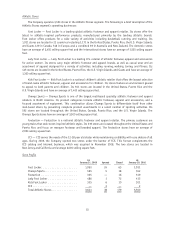Foot Locker 2009 Annual Report Download - page 20
Download and view the complete annual report
Please find page 20 of the 2009 Foot Locker annual report below. You can navigate through the pages in the report by either clicking on the pages listed below, or by using the keyword search tool below to find specific information within the annual report.Item 1A. Risk Factors
The statements contained in this Annual Report on Form 10-K (‘‘Annual Report’’) that are not historical facts,
including, but not limited to, statements regarding our expected financial position, business and financing plans
found in ‘‘Item 1. Business’’ and ‘‘Item 7. Management’s Discussion and Analysis of Financial Condition and
Results of Operations,’’ constitute ‘‘forward-looking statements’’ within the meaning of the Private Securities
Litigation Reform Act of 1995. Please also see ‘‘Disclosure Regarding Forward-Looking Statements.’’ Our actual
results may differ materially due to the risks and uncertainties discussed in this Annual Report, including those
discussed below. Additional risks and uncertainties that we do not presently know about or that we currently
consider to be insignificant may also affect our business operations and financial performance.
The industry in which we operate is dependent upon fashion trends, customer preferences, and other
fashion-related factors.
The athletic footwear and apparel industry is subject to changing fashion trends and customer preferences.
We cannot guarantee that our merchandise selection will accurately reflect customer preferences when it is
offered for sale or that we will be able to identify and respond quickly to fashion changes, particularly given the
long lead times for ordering much of our merchandise from vendors. A substantial portion of our highest margin
sales are to young males (ages 12−25), many of whom we believe purchase athletic footwear and licensed apparel
as a fashion statement and are frequent purchasers of athletic footwear. Any shift in fashion trends that would
make athletic footwear or licensed apparel less attractive to these customers could have a material adverse effect
on our business, financial condition, and results of operations.
If we do not successfully manage our inventory levels, our operating results will be adversely affected.
We must maintain sufficient inventory levels to operate our business successfully. However, we also must
guard against accumulating excess inventory. For example, we order the bulk of our athletic footwear four to
six months prior to delivery to our stores. If we fail to anticipate accurately either the market for the
merchandise in our stores or our customers’ purchasing habits, we may be forced to rely on markdowns or
promotional sales to dispose of excess or slow moving inventory, which could have a material adverse effect on
our business, financial condition, and results of operations.
The businesses in which we operate are highly competitive.
The retail athletic footwear and apparel business is highly competitive with relatively low barriers to entry.
Our athletic footwear and apparel operations compete primarily with athletic footwear specialty stores, sporting
goods stores and superstores, department stores, discount stores, traditional shoe stores, and mass merchandisers,
many of which are units of national or regional chains that have significant financial and marketing resources.
The principal competitive factors in our markets are price, quality, selection of merchandise, reputation, store
location, advertising, and customer service. Our success also depends on our ability to differentiate ourselves
from our competitors with respect to shopping convenience, a quality assortment of available merchandise and
superior customer service. We cannot assure you that we will continue to be able to compete successfully against
existing or future competitors. Our expansion into markets served by our competitors and entry of new
competitors or expansion of existing competitors into our markets could have a material adverse effect on our
business, financial condition, and results of operations.
Although we sell merchandise via the Internet, a significant shift in customer buying patterns to purchasing
athletic footwear, athletic apparel, and sporting goods via the Internet could have a material adverse effect on
our business results.
In addition, all of our significant vendors distribute products directly through the Internet and others may
follow. Some vendors operate retail stores and some have indicated that further retail stores will open. Should
this continue to occur, and if our customers decide to purchase directly from our vendors, it could have a material
adverse effect on our business, financial condition, and results of operations.
2


